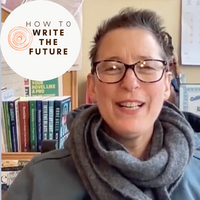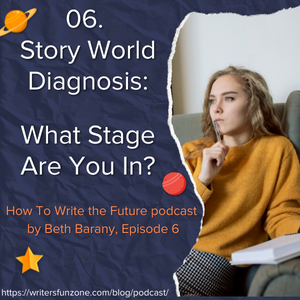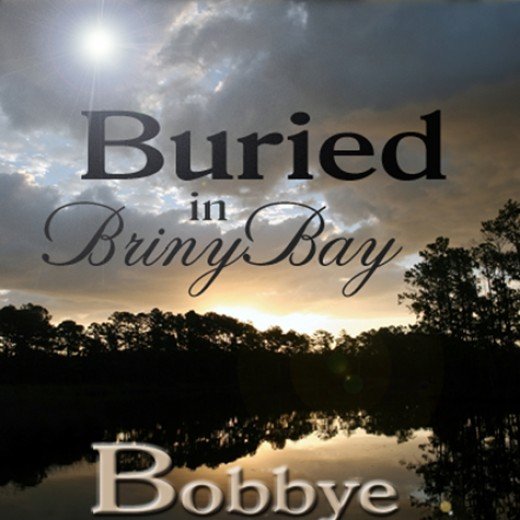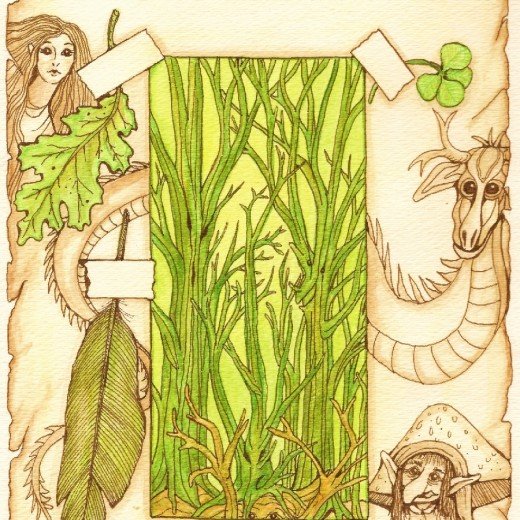Story World Diagnosis: What Stage Are You In by Beth Barany
In today’s latest episode of “How to Write The Future” titled “Story World Diagnosis: What Stage Are You In” I discuss the 5 main stages of building a story world.
For over 20 years, I have been world-building science fiction and fantasy novels and believe I have finally succeeded at creating compelling words that leave my readers wanting more. I want to share how you can bring your story world to life.
Have a listen to the latest episode on Apple Podcasts | Google Podcasts | Spotify| Buzzsprout | Amazon Music | Podcast Addict | Podchaser| Youtube
 Beth Barany is an award-winning novelist, master neurolinguistic programming practitioner, and certified creativity coach for writers, including being a workshop leader & keynote speaker. Beth has published books in several genres including young adult fantasy, paranormal romance, and science fiction mystery.
Beth Barany is an award-winning novelist, master neurolinguistic programming practitioner, and certified creativity coach for writers, including being a workshop leader & keynote speaker. Beth has published books in several genres including young adult fantasy, paranormal romance, and science fiction mystery.
Learn more about Beth Barany at these sites:
Author site / Coaching site / School of Fiction / Writer’s Fun Zone blog
RESOURCES
Plenty of World Building Resources available on Writers Fun Zone.
https://writersfunzone.com/blog/world-building-resources-for-fiction-writers/
SHOW NOTES
“You’re here because you’re starting out. Everybody starts here. Everybody. Your biggest challenge is how to start, how to overcome confusion and overwhelm, and maybe how to overcome some procrastination.”
In today’s podcast episode titled “Story Diagnosis: What Stage Are You In,” Beth Barany discusses the 5 main stages of building a story world that are based on her experience as a writing teacher and writing coach, and she shares solutions on how you can get your story world to the next level.
In this episode you will:
- Be able to identify the main stages of building a story world
- Gain direction on the symptoms to know which stage you are in
- Learn solutions on how you can progress through each stage.
QUESTIONS TO PONDER
— Where are you in these storyworld stages?
— Which one of these five stages do you find yourself in?”
— How do you enhance your character’s transformation story?
ABOUT HOW TO WRITE THE FUTURE
The How To Write The Future podcast is for science fiction and fantasy writers who want to write positive futures and successfully bring those stories out into the marketplace. Hosted by Beth Barany, science fiction novelist and creativity coach for writers.
Tips for fiction writers!
This podcast is for you if you have questions like:
- How do I create a believable world for my science fiction story?
- How do figure what’s not working if my story feels flat?
- How do I make my story more interesting and alive?
This podcast is for readers too if you’re at all curious about the future of humanity.
Connect with Beth Barany
TRANSCRIPT for 06. Story World Diagnosis: What Stage Are You In
Are you stuck with your world building and you don’t know how to make it come alive?
Maybe your storyworld feels like a flimsy stage set more than real life, and you don’t know what to do.
Or, maybe your story real world feels so real, but it’s missing something, and you don’t know what.
Or, maybe your story world feels like so many others — derivative.
And you want to make it feel unique, feel wow, make it be a place that readers yearn to visit. Like immediately. But you don’t know how to do that.
I know how you feel. Often my storyworld start out as sketches too — sets that have their back support structures showing.
Then, I work really hard to bring them to life and to enchant my readers, so they keep coming back for more.
Of course, there’s more than storyworld to bring a story to life.
A good storyworld though enhances your character’s transformation story. And your storyworld as experienced by your main character or point of view character brings it to life and is part of what makes your world unique.
But how do you do that?
We’ll go into this and more right now.
Hi podcast listeners. Welcome back to How To Write The Future with me, your host, Beth Barany. I am a science fiction and fantasy novelist, a writing teacher, and a creativity coach.
I created this podcast because I want us science fiction writers and speculative fiction writers to use our powers for good. I’m here to support your quest to write positive futures.
The How To Write The Future podcast is for science fiction writers who want to create optimistic stories.
Because when we vision what is possible, we help make it so.
I invite you into today’s episode to help you go from no storyworld to amazing story world.
BETH (2)02:12
I’ll say it again:
Because when we vision what is possible, we help make it so.
Today, I’m going to go into the main stages of building a story world, some of the symptoms to let you know which of these stages you’re in, and some solutions on how you can get to the next story world level.
Now, I have been working with writers for over 20 years, and myself been world-building fantasy and science fiction for at least that long, if not longer. I’ve struggled. I have yearned. And I think I have finally succeeded at creating compelling worlds that allow my readers to sink into the story and come out the other side amazed and wanting more.
I’ve identified five story stages.
As you listen, notice the stage you’re in and if these ring true for you. I’m very curious how they land for you.
The first stage is Storyworld Blank Page-itis.
You know you’re in this stage because you want to be writing. You want to be world-building.
You maybe have some inklings, very vague, but really nothing to show for it.
What you do have is the dream.
You’re in the stage because you’ve never built a story before. You’ve never built a new world. You have maybe a few details, a few notes, lots of questions. And maybe you’ve been studying craft books for while, but you haven’t really started.
You’re here because you’re starting out. Everybody starts here. Everybody. Your biggest challenge is how to start, how to overcome confusion and overwhelm, and maybe how to overcome some procrastination.
You really want to get out of this stage and propelled into the next stage: working on your book.
So, what do you need to get from here to the next stage?
You need some skills, you need some energy and enthusiasm, maybe even some confidence. You probably need some rudimentary storytelling skills, craft.
You need to put pen to paper or fingers to keyboard and start building your world.
Maybe you also need some inspiration. So you need to fill your creative well by doing research, talking to people, watching, reading.
And you really need to understand story structure, and world-building in general.
Once you get some knowledge, now we can move you into the next storyworld building stage.
I call the stage: Storyworld Doubt Creep.
Because you know you’re in the stage, stage two, when you’re right in the middle of learning craft, and you’re writing your story notes and you’re responding to world-building prompts, but you’re wondering: Is this right? Is this any good? Does this make sense?
At the stage, there’s a lot of stopping and starting and stalling. I know when I was in the stage, there was a lot of doubt, lot of concern. You’re wondering: Does this work?
There’s a lot of decisions to make.
Often the doubts make you freeze.
And the reason this keeps happening is a few things, maybe it’s perfectionism.
Maybe you’re worried about trends and sales, and are the reader’s going to like this?
And it’s hard to know, because this is your first attempt.
So, how do you get out of the stage and propelled into the third stage?
Well, persevere, keep going. It’s okay if you don’t know what you’re doing. That’s totally, totally normal.
Have people ask you questions, get with peer writers. It’s a little too early to hire an editor. I wouldn’t do that, especially because this is all about brainstorming.
You may need to do more research.
Also connect your greater WHY. Why are you writing the story?
And persevere and keep going with all your story planning and world-building.
Get support. This is often where people come to me as a writing teacher and coach and get feedback and support.
That and the steps I shared will move you into the third stage, which I call: Storyworld First Steps: Now What?
You’ve done all your story planning. And with that, you’ve also moved into drafting.
You know you’re in this stage because you have gone through your planning notes, if you do planning, and you have written a complete first draft.
I mean, crappy first draft.
Many elements of your story world are there. You have your character moving through the action of the story.
But now you’ve taken a step back and you notice: this doesn’t quite make sense.
Maybe critique partners are asking you: How come this and why that?
You realized you’ve left out a lot of nuances. There’s holes. There’s implications you haven’t thought about. So you’re concerned.
Do I scrap the book? How do I stitch this all together? How do I fix it?
What you really yearn for at this stage is clarity. Some more methods and tools on how to refine and edit the story. You love your story. Maybe you even feel really proud of what you’ve done. And I hope so. Writing a first draft is awesome. But maybe you feel a little bit embarrassed because you don’t have all the details quote, right? Like it doesn’t quite hang all together.
That’s okay. That was your first pass.
What you really want now is clarity and confidence. You want to know that your storyworld is robust, that your readers can really engage with your storyworld and really feel all the things about your world, and really experience the story through your character’s eyes.
What do you need to get to the next level?
You need to pressure test your story in your world. You need more information, new methodologies. Maybe you haven’t asked the right questions of your story. Maybe you need some more inspiration. The creative well may be empty again.
Now it’s time to go do some research and deepen into the signals on the fringes. What are the patterns outside mainstream media? Have you really picked up all the ways in which you can make your story world unique from the perspective of your main character?
So you dig in and you do the work.
Beth08:14
This is also where people come to me for support, so that I can help them spot all the holes in their work.
Now you’re in the fourth stage:
BETH (2)08:26
editing your story world for clarity and cohesion.
Beth08:30
You know, you’re in this stage when you’re stitching everything together.
BETH (2)08:35
You have found the answers to all your story world’s problems, and now you’re doing the work with an eye towards your audience.
So I was going to call this stage sell your story world.
Maybe I’ll call it, Edit and Sell Your Story World because this is where you’re editing. You’re bringing everything together. You want to make sure your readers are really going to find your story attractive.
What you’d love more than anything is to be able to sell your story, whether you’re selling it direct to readers as an independent author or you’re selling it to agents and editors as a traditionally published author.
At this stage, you want to really be able to identify:
what are the core concepts and values
Beth09:18
of your story world?
BETH (2)09:19
What is the foundational soap box of your storyworld?
What do you stand for?
And how does that connect with what your readers really want?
So what propels you into the next stage is identifying the key elements of your story world that speak to the audiences of today, really honing in on those setting details, values, even what’s kind of edgy about your story, so that you can communicate that attractiveness about your mission to your readers.
This propels you to the final stage, stage five, which I call Your Storyworld Is Alive. It’s alive. The Confident Selling Writer.
You have arrived. You know the value of your story and its world. You know the why’s and the wherefores, and you can confidently communicate that to your audience, so that your ideal readers can find your book and come buy your book.
You’ve arrived. Your book is out into the marketplace. You can now communicate in any form to various marketing mediums the awesomeness of your storyworld and your character. So go forth and market your novel.
So, that is the five stages of developing your storyworld for science fiction writers. Obviously this can be applied to fantasy writers and anybody who needs to build a cohesive, deep storyworld.
Granted, this was a, a flyover, a thirty thousand foot view.
Over the course of future episodes, I’ll dive deep into each one of these stages.
Now, I’d like your help.
I would like you to tell me through social media, through writing me, or even just think for yourself: where are you in these storyworld stages? Which one of these five stages do you find yourself in?
Also, do these ring true? What is missing? If anything, did I leave anything out? Should I add some more things in?
These five stages are based on my experience as a writing teacher and a writing coach, as well as my experience writing 16 science fiction and fantasy novels.
That’s what I base all this on.
I look forward to hearing from you. Please enjoy. Let me know if you have any questions about these five stages.
The best way to reach me is through LinkedIn or Twitter. Or through my website, Beth barany.com. That’s B E T H B A R A N Y Dot com
Until next time.
I’m Beth Barany, signing off from the How To Write The Future podcast.
Write long and prosper.
Loved this episode? Leave us a review and rating here: https://www.buzzsprout.com/2012061
or in your podcast home of choice.
***
CREDITS
EDITED WITH DESCRIPT
https://www.descript.com?lmref=_w1WCA (referral code)
MUSIC CREDITS
Music from Uppbeat (free for Creators!): https://uppbeat.io/t/soundroll/fuzz-buzz
License code: UMMKDRL02DFGKJ0L. “Fuzz buzz” by Soundroll.
Commercial license: https://musicvine.com/track/soundroll/fuzz-buzz
Distributed by Buzzsprout: https://www.buzzsprout.com/?referrer_id=1994465 (referral code)
SHOW PRODUCTION BY Beth Barany
SHOW NOTES SUPPORT from Kerry-Ann McDade
***
For more “How To Write the Future” episodes, go here.
If you’d like to invite Beth onto your podcast, drop her a note here.




